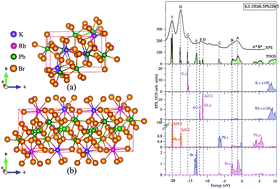Theoretical and experimental study on the electronic and optical properties of K0.5Rb0.5Pb2Br5: a promising laser host material
Abstract
The data on the electronic structure and optical properties of bromide K0.5Rb0.5Pb2Br5 achieved by first-principle calculations and verified by X-ray spectroscopy measurements are reported. The kinetic energy, the Coulomb potential induced by the exchange hole, spin-orbital effects, and Coulomb repulsion were taken into account by applying the Tran and Blaha modified Becke–Johnson function (TB-mBJ), Hubbard U parameter, and spin-orbital coupling effect (SOC) in the TB-mBJ + U + SOC technique. The band gap was for the first time defined to be 3.23 eV. The partial density of state (PDOS) curves of K0.5Rb0.5Pb2Br5 agree well with XES K Ll and Br Kβ2, and XPS spectra. The valence band (VB) is characterized by the Pb-5d3/2 and Pb-5d5/2 sub-states locating in the vicinities of −20 eV and −18 eV, respectively. The VB middle part is mainly formed by K-3p, Rb-4p and Br-4s states, in which the separation of Rb-4p3/2 and Rb-4p1/2 was also observed. The strong hybridization of Br-p and Pb-s/p states near −6.5 eV reveals a major covalent part in the Br–Pb bonding. With a large band gap of 3.23 eV, and the remarkably high possibility of inter-band transition in energy ranges of 4–7 eV, and 10–12 eV, the bromide K0.5Rb0.5Pb2Br5 is expected to be a very promising active host material for core valence luminescence and mid-infrared rare-earth doped laser materials. The anisotropy of optical properties in K0.5Rb0.5Pb2Br5 is not significant, and it occurs at the extrema in the optical spectra. The absorption coefficient α(ω) is in the order of magnitude of 106 cm−1 for an energy range of 5–25 eV.



 Please wait while we load your content...
Please wait while we load your content...